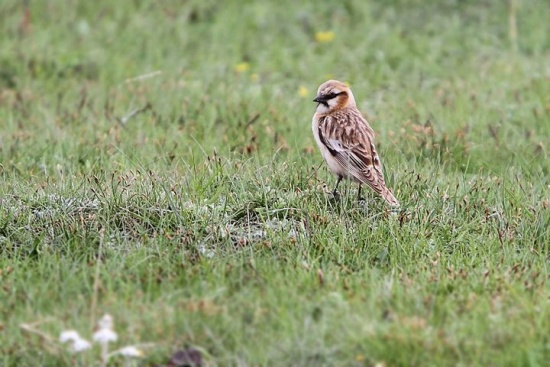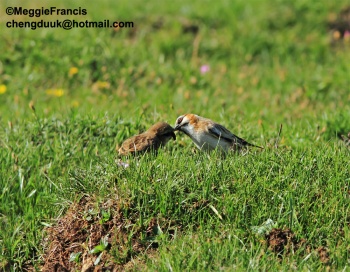Alternative names: Rufous-necked Ground-Sparrow; Red-necked Snowfinch; Red-necked Ground-Sparrow
- Pyrgilauda ruficollis
Montifringilla ruficollis
Identification
23 - 28cm. A distinctive Snowfinch:
- Small, pointed bill
- Mainly rufous-brown plumage
- Long, black eye-stripe
- Black moustachial streak
- White throat
- Rufous half-collar
- Strongly streaked mantle
- White on upperwing-coverts usually not prominent in field
Females have browner head markings and less white in wing than males. Juveniles are plainer and tawnier with less prominent head markings.
Similar species
See Blanford's Snowfinch.
Distribution
Found mainly on the Tibetian plateau to central China and to the Himalayas of Nepal and India.
Common in most of its range, scarce in Nepal and India.
Taxonomy
Two subspecies accepted:
- P. r. ruficollis in south and east Tibet to central China (southwest Qinghai and western Sichuan) and in India and Nepal
- P. r. isabellina in northern Tibet
Habitat
Grassy plateaux and high barren stony steppes, often near watercourses or rubbish tips near human habitation. Associated with pika and vole colonies but less than eg. Blanford's Snowfinch. Prefers rockier, steeper and more eroded steppe than White-rumped Snowfinch. Occurs at 3500 - 5000m.
Behaviour
Feeds on seeds and insects. Forages on ground, searching dung of domestic animals.
Usually seen in pairs or small flocks. In winter in larger flocks with other snowfinches.
Breeding season from May to June. Breeds solitary or in small groups. In early spring the male sings a short strophe from the ground. Later it displays in groups, soundlessly rising and singing while diving down. The nest is made of plant material and placed in a rock hole or in the burrow of a mammal, particularly Brandt's vole. Lays 4 - 5 eggs.
A nomadic species. Moves down in winter.
References
- Clements, JF. 2009. The Clements Checklist of Birds of the World. 6th ed., with updates to December 2009. Ithaca: Cornell Univ. Press. ISBN 978-0801445019.
- Del Hoyo, J, A Elliott, and D Christie, eds. 2009. Handbook of the Birds of the World. Volume 14: Bush-shrikes to Old World Sparrows. Barcelona: Lynx Edicions. ISBN 978-8496553507
- Rasmussen, PC and JC Anderton. 2005. Birds of South Asia: The Ripley Guide. Barcelona: Lynx Edicions. ISBN 978-8487334672
Recommended Citation
- BirdForum Opus contributors. (2024) Rufous-necked Snowfinch. In: BirdForum, the forum for wild birds and birding. Retrieved 8 November 2024 from https://www.birdforum.net/opus/Rufous-necked_Snowfinch





